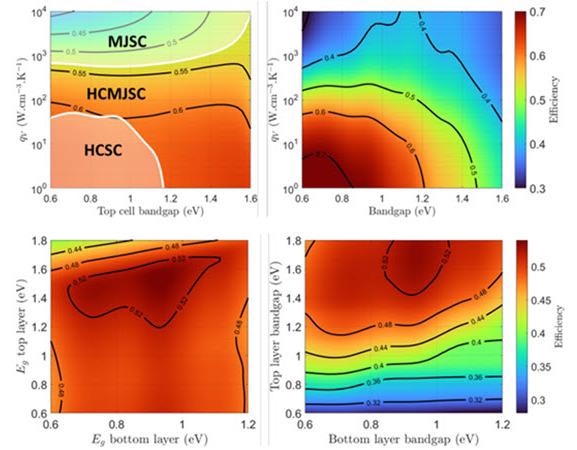Solar energy is considered to be a clean and renewable source of energy. Generally, Solar cells have a semiconductor material that has the potential to absorb sunlight and produce electricity. But the amount of sunlight that could be transformed into electricity is restricted.

Efficiencies of the MJSC, HCMJSC and HCSC panels as a function of the bandgap and thermalization coefficient. The novel HCMJSC design, investigated by the researchers, shows higher resilience to nonoptimal bandgaps and less constrained thermalization requirements, widening the scope of candidate materials for its design. Image Credit: Giteau et al., doi.org/10.1117/1.JPE.12.032208.
Standard single-junction solar cells have been restricted in a theoretical manner to an utmost power conversion efficiency (PCE) of 30%. This is the well-known “Shockley–Queisser Limit,” which comes from a trade-off between charge carrier and light absorption thermalization.
To beat this limit and reach greater efficiencies, various designs for solar cells have been taken into account. For example, hot-carrier solar cells (HCSCs) utilize the surplus kinetic energy of photoexcited electrons (prior to being lost as heat) to enhance PCE. However, these designs have not managed to surpass the Shockley–Queisser limit in practice.
This could be a result of their sensitivity to so-called “nonidealities.” In simple terms, deviations caused from perfect scenarios, as a result of imperfect design, operating conditions, or nonoptimal materials, decreases their PCE down to or below the Shockley–Queisser limit.
Therfore, conversion strategies need to take into account the flexibility of solar cell designs against these nonidealities.
Against this backdrop, an international research group tested the strength of a hot carrier multijunction solar cell (HCMJSC), novel solar cell architecture to nonideal design along with nonoptimal materials.
The HCMJSC included a panel with a thin hot carrier top junction series linked to a thick cold bottom junction. They made a comparison of its performance along with those of the reference standards set by HCSC and multijunction solar cells (MJSCs). Their outcomes have been reported in the SPIE Journal of Photonics for Energy (JPE).
As stated in JPE, the scientists assessed the PCEs with the help of a model that accounted for several junctions and hot-carrier effects, thereby implementing a standard absorption model. They assessed how the PCE got altered with tuning parameters like bandgap, incident intensity, temperature, absorber thickness, and thermalization rate (determining the rate at which the photoelectrons tend to lose their additional kinetic energy).
As far as the optimal designs are concerned, the HCSC illustrated the greatest PCE, followed by MJSC and HCMJSC. But the HCMJSC displayed a comparatively lower drop in efficiency for nonoptimal designs (materials with finite thermalization rates and nonoptimal bandgaps), thus illustrating excellent flexibility to design imperfections.
The HCMJSC displayed highly relaxed requirements for hot carrier thermalization than the HCSC. This enabled it to surpass the best MJSC efficiency achieved with available thermalization coefficients. Also, it broadened the range of candidate materials ideal for developing HCMJSCs.
Eventually, the scientists tested for flexibility against operating conditions to guarantee that the resilience against design flaws was not obtained at the expense of increased sensitivity to external conditions.
This was performed by assessing the yearly averaged efficiencies for nonideal solar illumination (calculated with the help of a standard reference spectrum): all three designs displayed a lower average efficiency compared to their nominal values. While high-bandgap HCMJSCs were performed similar to MJSCs, low-bandgap HCMJSCs were somewhat highly sensitive to illumination effects.
Hot-carrier photovoltaics have been proposed since the early 1980s as a way to achieve higher efficiencies than break the conventional ‘detailed-balance’ limit, but they have yet to be realized in practice.
Sean Shaheen, JPE Editor-in-Chief, University of Colorado Boulder
Shaheen added, “The work by Giteau and colleagues provides a strategy to bring them closer to fruition by loosening the constraint of near-perfect materials, which otherwise easily reduces the performance of real-world devices.”
On the whole, this study offers significant insights into what factors tend to impact solar cell performance and the flexibilities that are appropriate for their applications and other technologies in the field. This possibly sets the stage for better solar cell designs.
Journal Reference:
Giteau, M., et al. (2022) Hot-carrier multijunction solar cells: sensitivity and resilience to nonidealities. Journal of Photonics for Energy. doi.org/10.1117/1.JPE.12.032208.